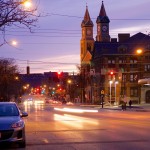Tomorrow night will be the second meeting of the Liberty Street Safety Improvement Study – an effort previously called the Liberty Street Complete Street Project in its 2013 iteration.
At the meeting, Cincinnati’s Department of Transportation & Engineering will present various concepts for the street’s reconfiguration, including five separate options at seven lanes, and additional six, five, four and three-lane options. Many of these scenarios contribute enough additional space to make development on the south side of Liberty Street feasible.
A major consideration, as the project’s title would suggest, is the safety of pedestrians and bicyclists that share the roadway. The current excessive width of the road, coupled with the speed of cars, contributes to an environment incongruous to pedestrian and cyclist safety.
Other elements being considered include pedestrian and cycling facilities, development potential on the south side of Liberty Street, streetscape aesthetics, automobile capacity/safety, and the preservation of on-street parking.
Both current and past public input, like the 2011 Brewery District Master Plan, stress a strong desire to improve the connection of urban fabric between the northern and southern portions of Over-the-Rhine.
“Liberty Street cuts off two sections of OTR,” said Frank Henson, a local cycling advocate. “All other north-south routes get cut up by the expansive width of Liberty; and I support narrowing it, with the inclusion of space for bicycle facilities.”
Many believe that the narrowing of Liberty Street can accomplish both of these objectives; although questions remain about how much narrowing is appropriate, and what should be done with the additional space that is made available.
According to data from the OKI Regional Council of Governments, Liberty Street has an annual average daily traffic (AADT) count of 14,278, which is actually less than the much narrower Ludlow Avenue’s 14,551 AADT in Clifton.
Ludlow Avenue has parking on both sides of the street, aside from peak hours from 7am to 9am where it is prohibited on the south side of the road, and 4pm to 6pm where it is prohibited on the north side of the road. This means that Ludlow Avenue, with its nearly identical traffic count, has fewer lanes of traffic during both peak and non-peak hours.
Martin Luther King Drive, near the University of Cincinnati’s main campus, has the same width as Liberty Street, but carries upwards of 20,000 AADT; and portions of Reading Road carry more than 25,000 AADT with just five lanes.
As a result, one could then deduce that travel demand on Liberty Street is far, far less than its width warrants.
Should Liberty Street be significantly narrowed, based on these figures, it could still absorb its current capacity, and, if necessary, divert traffic to Central Parkway, Fort Washington Way, or one of the many east-west thoroughfares that also have highway access.
Option 7d includes a “shared use bicycle/pedestrian pathway;” and while this widened path is intended to accommodate both pedestrians and cyclists, it is generally considered a less safe practice, as compared to separate facilities, to mix the two due to the faster travel speeds of people on bicycles.
An option that has bike and pedestrian facilities, preserves on-street parking, while also providing three travel lanes could reduce speed, increase safety, provide additional space for development, and still manage capacity based on comparable traffic counts.
The Ludlow Avenue and Reading Road examples disprove the idea that any decrease in capacity would be crippling. However, should demand increase, traffic is also highly divertible to other thoroughfares within a short distance.
Residents and interested parties can express their opinions on Tuesday, March 1 from 6pm to 8pm at the Woodward Theater in Over-the-Rhine. City officials say that they hope to narrow the alternatives to two following this meeting.

